I love to fish for anything that swims in saltwater, yet I’m an offshore man at heart. And while I’ve spent decades chasing marlin, sailfish, tuna, swordfish, wahoo and dolphin, everyone has their favorite game fish, including me. If someone forced me to narrow my favorite to just one species, I’d tightly squint my eyes, take a deep breath and say, “dolphin!” I doubt I would be alone in this decision.
There’s just something about dolphin fishing that inspires thousands of offshore anglers to buy all sorts of rods and reels, fishing lines, hooks, mahi lures, baits and gaffs in anticipation of the upcoming season. And for very good reasons: Here is a fish that is abundant, comes in all sizes, puts up a great and oftentimes acrobatic fight, commonly blitzes in schools or pairs (larger fish) and is downright delicious to eat. Dolphin are so popular that it is frightening to imagine what our industry would look like if they ceased to exist.
I’ve taken a deep interest in mahi mahi fishing and have perfected my tactics over the years. Whether it’s figuring out the best lures for dolphin fishing or testing which mahi trolling rigs top them all, my determination to find what works has paid off. If you want to know how to catch mahi, you’ve come to the right place. When I set forth to target them, the following dolphin fishing rigs rank among my most potent dolphin catchers.
Horse Ballyhoo for Dolphin
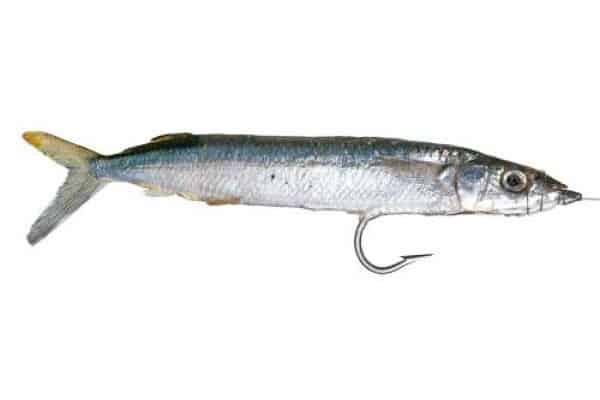
I prefer to headhunt for larger fish when trolling for dolphin and would rather take one 30-plus-pound dolphin than a dozen 3- to 5-pounders any day. Therefore, my spread consists mostly of large and horse ballyhoo, each rigged to several feet of 110-pound-test fluorocarbon leader and a single 9/0 long-shank hook.
The reason I use this rig is that big baits eliminate the smaller fish. You know the drill: School dolphin blitz a spread of smaller lures and baits, and all the lines go down. After the fish are boated, the boat moves along and the lines go back out only to hook up with some more schoolies; you ultimately spend most of your time dealing with small fish. School dolphin are intimidated by large baits. Outside of possibly pecking, they’ll leave the bigger baits alone. And this unmolested soak time dramatically increases the odds of attracting larger dolphin, which have no problem consuming big baits.
Rig Ballyhoo Weedless

Anglers quickly tire of picking weeds off their baits in areas of heavily scattered sargassum and often head off in search of cleaner waters. Yet those in the know stick it out, especially if bait abounds underneath the grass mats.
In such a situation, I deploy a spread of weedless ballyhoo, which are similarly rigged to the large ballyhoo baits outlined previously. The main difference is that the hook point is inverted back into the bait, where it won’t snag weeds, and the wire tag that usually sticks up through the bait’s bill is reversed so it points down into the bait. Thus, the bait is rigged much like a plastic bass worm.
To rig it, run the hook point through the ballyhoo’s gill slit and immediately out its throat. Pull most of the hook shank through, and then reverse the hook point and insert it back into the bait. Once the hook is positioned where it’s not binding, push the pin rig through both jaws of the bait and secure the bait and hook with a strand of Monel wire. To do this, pass the wire through the bait’s eyes and then make several tight wraps around the head, behind and in front of the pin, and all the way down, finishing with a couple of wraps on the leader.
Add a small skirt over the nose of the ballyhoo to deflect weeds from its bill, and scale the bait’s midsection and belly near where the hook point is resting; this will “soften” the bait and facilitate the hook’s pulling out and latching into a fish during the strike.
Ballyhoo Pitch Bait
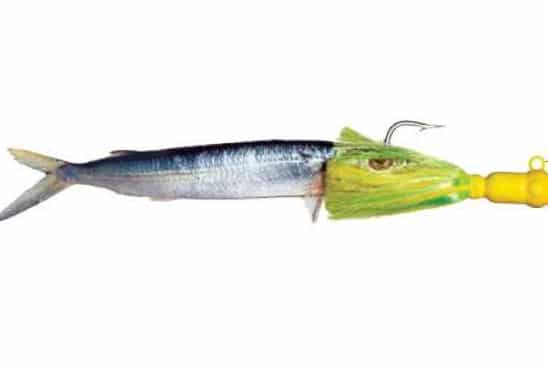
One of the deadliest tactics for big dolphin is keeping handy a 20-pound-class spinning outfit rigged with a medium to large ballyhoo. Should a large dolphin appear on the periphery of a school of smaller fish, under debris or under working birds, immediately pitch the ballyhoo or slowly troll it around the working birds on an intercept course with the fish. When a dolphin strikes, free-spool the bait, let the fish swallow it, and then engage the drag and have fun!
I rig my pitch-bait rods with a short Bimini twist, followed by a Bristol knot to join that Bimini to about 4 feet of 50-pound-test fluorocarbon leader. I’ll use a loop knot to join an 8/0 live-bait-style hook to the leader. The ballyhoo is attached by simply running the hook point underneath and out its jaws. Another option, for casting distance or dropping down to deep fish, is to impale the ballyhoo on a 3- or 4-ounce yellow bucktail jig.
Add Dredges to Your Trolling Spread

One of my favorite trolling additions, a dredge helps create the illusion of a baitball in the water column. I fish a dredge off each cockpit corner of my 28-foot center console, and they complement a surface teasing arrangement of a spreader bar and a large hookless lure.
The sight of two 96-fish Stripteaser dredges unfurling in the water is exciting. They’re fished just far enough back and just deep enough that we can still see them and can react to any fish that comes in on them. Usually, that sweet spot on my boat is about 15 feet back and about eight to 10 feet deep. We’ve had dolphin as large as 40 pounds come up in these dredges. And interestingly enough, they work equally as well when we’re shut down and catching school fish — just cleat them tight to the transom, where they’ll flutter and reflect light just underneath the boat.
Catch Baitfish at the Weed Lines

When angling pressure or a full moon keeps dolphin from feeding, try using their natural forage. That is, use a bait quill rig to acquire several of those banded rudderfish and other small specimens that cling tightly to weeds and debris. These comprise the dolphin’s natural forage and often produce when “import” baits, such as pilchards and sardines, fall short.
Drop these baits into a five-gallon bucket of seawater to keep them at the ready. Then impale one on a 2/0 or 3/0 live-bait-style hook that is rigged to a 20-pound-test fluorocarbon leader and a light, 8-pound-class spinning outfit. The light outfit pitches the bait a fair distance, and the light hardware lets it swim enticingly.
Jigging for Dolphin
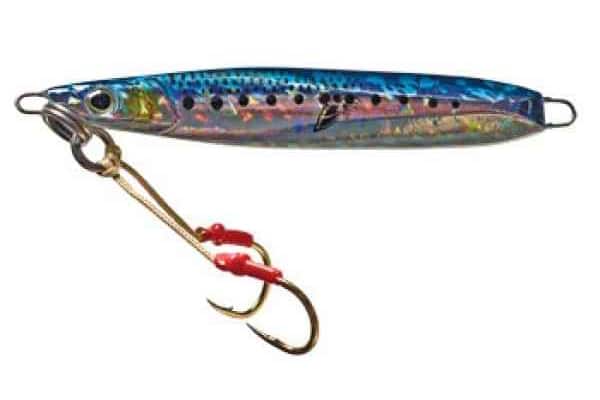
Another method for pulling up dolphin that have sounded is dropping a flutter-style iron some 100 feet deep and then radically jigging it back to the surface. This iron, rigged with 4 feet of 50-pound-test fluorocarbon leader and joined to the short Bimini twist in the fishing line with a barrel swivel, can be dropped straight beneath a weed line or debris or fan-cast around the boat and allowed to sink. Good color choices are blue-and-silver (flying fish), pink-and-white (squid) and green-and-orange (dolphin).
Trolling Lures Imitate Flying Fish
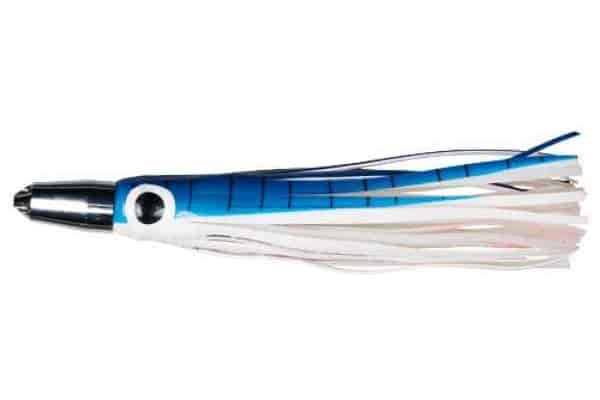
Small Trolling Lures
When running and gunning for dolphin, keep at least two outfits rigged with small, blunt-headed trolling lures. The best color combinations are blue-and-white and green-and-orange. When you find birds working, pitch out the lures, throttle up to a fast trolling speed and head toward them. These lures mimic the size of flying fish, favorite dolphin forage, and withstand the rigors of faster trolling speeds better than natural baits.
When you reach your target or find another likely spot, such as a floating board or big weed patch, slow the boat to a reasonable trolling speed and make a few passes. If dolphin are around, they’ll ambush these lures. Small lures fished this way have yielded many large dolphin for me. And of course, these lures are mainstays in catching school fish. I prefer to rig my lures with 6 feet of 110-pound-test fluorocarbon leader and a single 8/0 long-shank hook that’s positioned with spacer beads to ride near the tail end of the lure skirt. I’ll either crimp or tie a loop at the end of the leader and keep a half-dozen of these lures close at hand, if not already on an outfit or two.
Cut Baits for Dolphin

This dolphin standard, usually reserved for when the magic runs out of the jigs, is still a favorite for catching school fish. A chunk of ballyhoo is simply impaled on a 4/0 to 6/0 live-bait-style hook attached to a 50-pound-test leader on a 12- or 20-pound-class spinning outfit. Often, for dolphin-bailing, the leader is between 15 and 20 feet long. This way, when the leader becomes abraded after catching a fish or two, you simply cut it back a few inches, retie the hook, rebait and catch another fish in short order.
But chunking for dolphin tuna-in-the-canyon style is a deadly and little practiced tactic. When you happen on a weed line or an area where you’ve seen a dolphin or two and trolling isn’t cutting it, go on the chunk. Float out a few lines, each baited with a chunk of ballyhoo, sardine or squid. Add a few ounces of weight on one line with a rubber-core sinker or an egg sinker rigged with a rubber band in breakaway fashion (6 to 10 feet above the leader), followed by a balloon float some 30 to 40 feet up the fishing line (based on how deep you want the chunk to fish). Deploy two more outfits, one deeper and one free-lined at the surface. Cut up your extra ballyhoo or sardines, and toss over a few chunks until they fade from sight. Then repeat the tactic. If dolphin are in the area, sooner or later one of these baits will get eaten. And oftentimes, you’ll bring up a school of energized fish and set off a feeding blitz.
Live Shrimp for Dolphin

Live Shrimp
A “secret” taught to me at an early age was to take several dozen live shrimp when dolphin fishing. We’d put the shrimp in a traditional live-bait bucket and then place that bucket into the boat’s livewell. The bucket enabled us to get to the shrimp quickly rather than chasing them with a net in the large, open livewell. When we uncovered stubborn dolphin or when a school grew wise to all other offerings, we’d pitch out a live shrimp rigged in a way similar to the light spinning rig I described earlier. I’ve yet to see a dolphin refuse one. In fact, my most vivid memory of this tactic occurred 30 years ago, when we happened upon a large school of fish that would not touch a thing – including live pilchards. Dejected, we rigged with a live shrimp, thinking our final option would also be ignored. Some 34 fish in the box later, I was shocked at just how potent a bait it proved to be.
Use Poppers for Dolphin
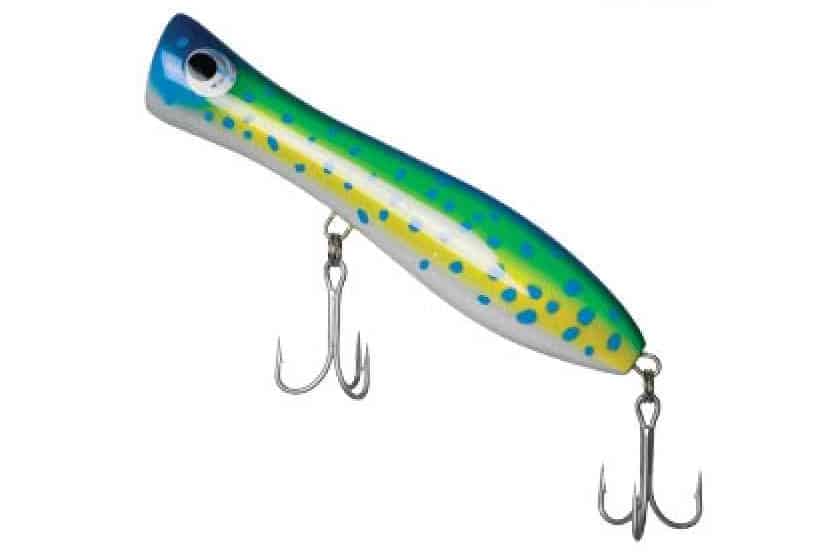
A consistent trick to bring dolphin back to the boat and rally their feeding instinct is to fan-cast a large chugger over a large swath of water. Radically work that chugger rapidly, making it chug and spit water as it races back to the boat. The enticement here is twofold. First, the deep chugging sound permeates far and wide through the water to pique the dolphins’ interest. Second, the sight of the chugger fleeing as if from a predator triggers the dolphins’ aggressive nature. Once the fish rise to the chugger, pull the lure from the water and pitch a traditional bait.









